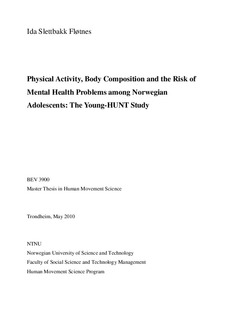Physical Activity, Body Composition and the Risk of Mental Health Problems among Norwegian Adolescents: The Young-HUNT Study
Master thesis
Permanent lenke
http://hdl.handle.net/11250/271463Utgivelsesdato
2010Metadata
Vis full innførselSamlinger
Sammendrag
Background: The aim of the study was to examine the associations of physical activity, sport participation, -and body composition on the risk of symptoms of mental health problems in a large population-based sample of Norwegian adolescents.
Methods: Analyses were based on 4-year longitudinal data from the Young-HUNT studies in Norway among adolescents aged 13–19 years. A total of 2399 students participated in both Young-HUNT 1 and Young-HUNT 2, and 2000 of these were eligible for data analysis. We calculated relative risks of anxiety/depression symptoms (SCL-5 ≥ 2) associated with the various measures of physical activity and sports participation, anthropometric measures, and self-image of body size.
Results: There was no associations between days of physical activity and the risk for symptoms of anxiety/depression among girls (P-trend = 0.34). Among boys we found an inverse association (P-trend = 0.02). For both genders the RR was higher for those who reported that they were not active in sports compared to those who were active (adjusted RR = 1.24; 95% CI= 0.86 – 1.79 for girls and RR = 1.43; 95% CI= 0.84 – 2.44 among boys). Girls with high BMI had a slightly higher risk for symptoms of anxiety/depression (adjusted RR= 1.19; 95% CI= 0.88- 1.62), and boys with low BMI had a higher risk (adjusted RR= 1.59; 95% CI= 0.80 – 3.15). Girls who considered themselves “very fat/chubby” or “thin/very thin” had a higher risk than those who considered themselves as “about the same as others” (adjusted RRs were 1.38; 95% CI= 1.04 – 1.67 and 1.71; 95% CI= 0.80 – 1.40, respectively). In boys, the risk was highest for those who considered themselves as “thin/very thin” (adjusted RR= 1.73; 95% CI= 1.11 – 2.67).
Conclusion: Our findings indicated that days of physical activity may influence some aspects of mental health in boys, but not in girls. When measuring mental health status, body composition, and amount of physical activity, it is important to consider gender differences. Results encourage a search for further knowledge about physical activity as a possible protective factor in relation to mental health problems in adolescence.
